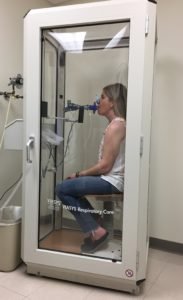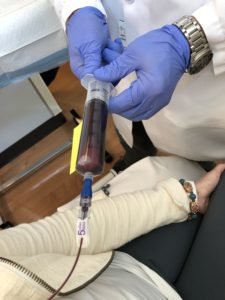The Waiting Zone
“It’s because you are sick. You may not look it, but you are. You have a 28 MELD score for a reason.” Hard words to swallow, but true. This is what my husband, Noah, said to me on the way home, as I sat in the passenger seat exhausted from grocery shopping. On the way to Whole Foods, I had the extreme exhaustion feeling. The kind that takes great effort to answer a question. I was hoping our lunch before grocery shopping would help, but it didn’t. As we ate lunch, my heart was beating at a faster than normal pace and I felt crummy all over. I knew it was going to be difficult to grocery shop. I tried to fight through it but continued to feel worse with each passing aisle. My heart was racing, I felt lightheaded as if I just ran many miles. I had to give in to it and told Noah I needed to go sit in the car. He gave me the keys and went to the register to pay. When I got to the car, I used my fingertip pulse oximeter to check my heart rate—it was 116. That is extremely high for just meandering around a grocery store. I was quiet most of the ride home, focusing on my breathing and trying to get my heart rate down. It eventually plateaued in the low 90s. My doctor advised me that when the body is trying to fight something, the heart rate increases because it is under stress and working extra hard. As my body continues to fight bile duct infections due to my rare autoimmune liver disease, primary sclerosing cholangitis, I have bouts of increased heart rate. It makes me sad that this is my world right now, feeling weak and sick every day as I wait for a life-saving liver transplant.Living in the waiting zone is a tough place to be. My liver transplant evaluation at CA Pacific Medical Center (CPMC) took place in the middle of February 2018 and it took from then until June 21, 2018, until I officially became active on the liver transplant waitlist. My MELD score is 28, which isn’t high enough for me to get offers for a liver transplant in California. This whole process has been go-go-go through the transplant evaluation and then wait for the transplant center’s decision.  Then, hurry up with evaluation requirements and wait. Wait for doctors to review your case, wait for appointments to be scheduled, wait for test results, wait to get procedures done, wait to hear what your MELD score is from the regional committee, wait for insurance approval and wait to hear that you are officially active on the waitlist. As a patient, we must have patience. There are so many unknowns and so many things that are out of your control. It is hard to feel helpless when we so badly want to do anything to feel better.Even though I am officially on the waitlist in CA, I continue to move forward with getting listed at Barnes Jewish Center in St. Louis, MO,
Then, hurry up with evaluation requirements and wait. Wait for doctors to review your case, wait for appointments to be scheduled, wait for test results, wait to get procedures done, wait to hear what your MELD score is from the regional committee, wait for insurance approval and wait to hear that you are officially active on the waitlist. As a patient, we must have patience. There are so many unknowns and so many things that are out of your control. It is hard to feel helpless when we so badly want to do anything to feel better.Even though I am officially on the waitlist in CA, I continue to move forward with getting listed at Barnes Jewish Center in St. Louis, MO,  because a MELD score of 28 in St. Louis would put me at the top of their waitlist. I encourage you to read a recent post, Need Liver - Will Travel, which shares my transplant evaluation experience in St. Louis. The evaluation took place at the end of May 2018 and I am still waiting for an answer as to whether they will approve me to be listed for transplant. They reviewed my case and the team wanted me to get an ERCP to rule out cancer in my liver before they will agree to move forward. I am hoping to get those final test results this week and an answer from Barnes Jewish Center’s transplant team. If they give the green light, then I’m in the next waiting zone of them getting insurance approval and petitioning to their regional committee to see if they can obtain the same amount of MELD points as CA has for me. If this all goes well, then it will be time to relocate to St. Louis.Wow! As you can tell, receiving a transplant doesn’t just happen. It takes a lot of work and a lot of waiting, all while trying to manage decreasing health and not feeling well. We aren’t sitting here with a common cold. We are in need of a new organ. It is important for us to be our own best advocate and do our patient tasks as quickly as possible to keep the ball rolling, like lab work, tests, procedures, completing paperwork, going to doctor appointments, etc. It is also important that we follow-up with our transplant team and make sure they are on track and moving things along as quickly as possible.The waiting zone can be exhausting, frustrating and quite emotional. We are fighting for our lives in hopes to receive a second chance and get back to living a better quality of life.
because a MELD score of 28 in St. Louis would put me at the top of their waitlist. I encourage you to read a recent post, Need Liver - Will Travel, which shares my transplant evaluation experience in St. Louis. The evaluation took place at the end of May 2018 and I am still waiting for an answer as to whether they will approve me to be listed for transplant. They reviewed my case and the team wanted me to get an ERCP to rule out cancer in my liver before they will agree to move forward. I am hoping to get those final test results this week and an answer from Barnes Jewish Center’s transplant team. If they give the green light, then I’m in the next waiting zone of them getting insurance approval and petitioning to their regional committee to see if they can obtain the same amount of MELD points as CA has for me. If this all goes well, then it will be time to relocate to St. Louis.Wow! As you can tell, receiving a transplant doesn’t just happen. It takes a lot of work and a lot of waiting, all while trying to manage decreasing health and not feeling well. We aren’t sitting here with a common cold. We are in need of a new organ. It is important for us to be our own best advocate and do our patient tasks as quickly as possible to keep the ball rolling, like lab work, tests, procedures, completing paperwork, going to doctor appointments, etc. It is also important that we follow-up with our transplant team and make sure they are on track and moving things along as quickly as possible.The waiting zone can be exhausting, frustrating and quite emotional. We are fighting for our lives in hopes to receive a second chance and get back to living a better quality of life. Some days can feel quite stagnant, where it seems like our life is in a standstill and everyone else is going about their wonderful lives—like someone hit pause on our lives, yet we can see everything else moving around us. We wish all of the details and processes associated with getting a transplant would move quicker and that we could help speed up all of the things that are beyond our control. We’d give anything for a magic wand to tell us where and when our transplant will be so we don’t have to walk this tightrope of unknowns. The waiting area is a foggy space where we imagine better days, and hope there will be a day when our health is restored and we feel well again.I’ll continue to live in the waiting zone with as much grace as possible, hoping that St. Louis will approve me for transplant—that they will be able to obtain a high enough MELD score for us to relocate and be in the position to receive an offer for a new liver. Or maybe I’ll move up the list in CA and get a transplant at CPMC. So many unknowns. However, I know that waiting will take on a whole new life as we get to the phase of waiting for “the call.” I can’t even fathom how I will feel when I get waved out of the waiting zone and the next chapter of my new life will begin when I can say, “Goodbye waiting zone,” and “Hello days where grocery shopping won’t feel like I ran a marathon.”
Some days can feel quite stagnant, where it seems like our life is in a standstill and everyone else is going about their wonderful lives—like someone hit pause on our lives, yet we can see everything else moving around us. We wish all of the details and processes associated with getting a transplant would move quicker and that we could help speed up all of the things that are beyond our control. We’d give anything for a magic wand to tell us where and when our transplant will be so we don’t have to walk this tightrope of unknowns. The waiting area is a foggy space where we imagine better days, and hope there will be a day when our health is restored and we feel well again.I’ll continue to live in the waiting zone with as much grace as possible, hoping that St. Louis will approve me for transplant—that they will be able to obtain a high enough MELD score for us to relocate and be in the position to receive an offer for a new liver. Or maybe I’ll move up the list in CA and get a transplant at CPMC. So many unknowns. However, I know that waiting will take on a whole new life as we get to the phase of waiting for “the call.” I can’t even fathom how I will feel when I get waved out of the waiting zone and the next chapter of my new life will begin when I can say, “Goodbye waiting zone,” and “Hello days where grocery shopping won’t feel like I ran a marathon.” How do you handle living in the waiting zone?
How do you handle living in the waiting zone?
